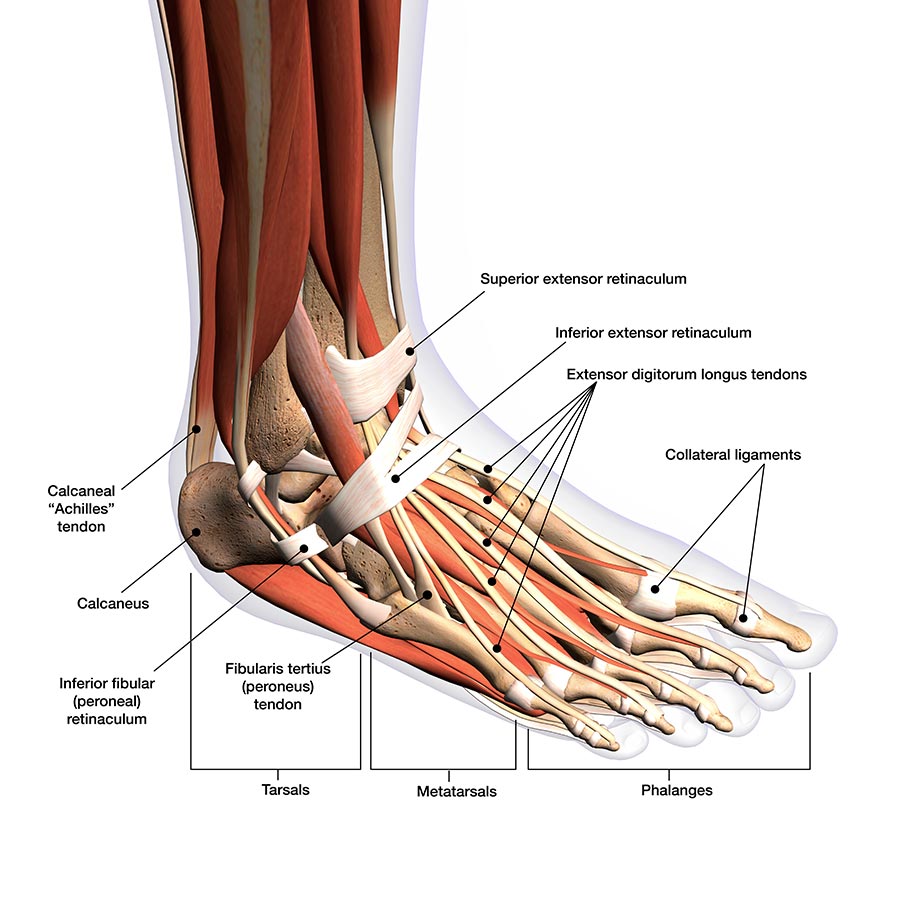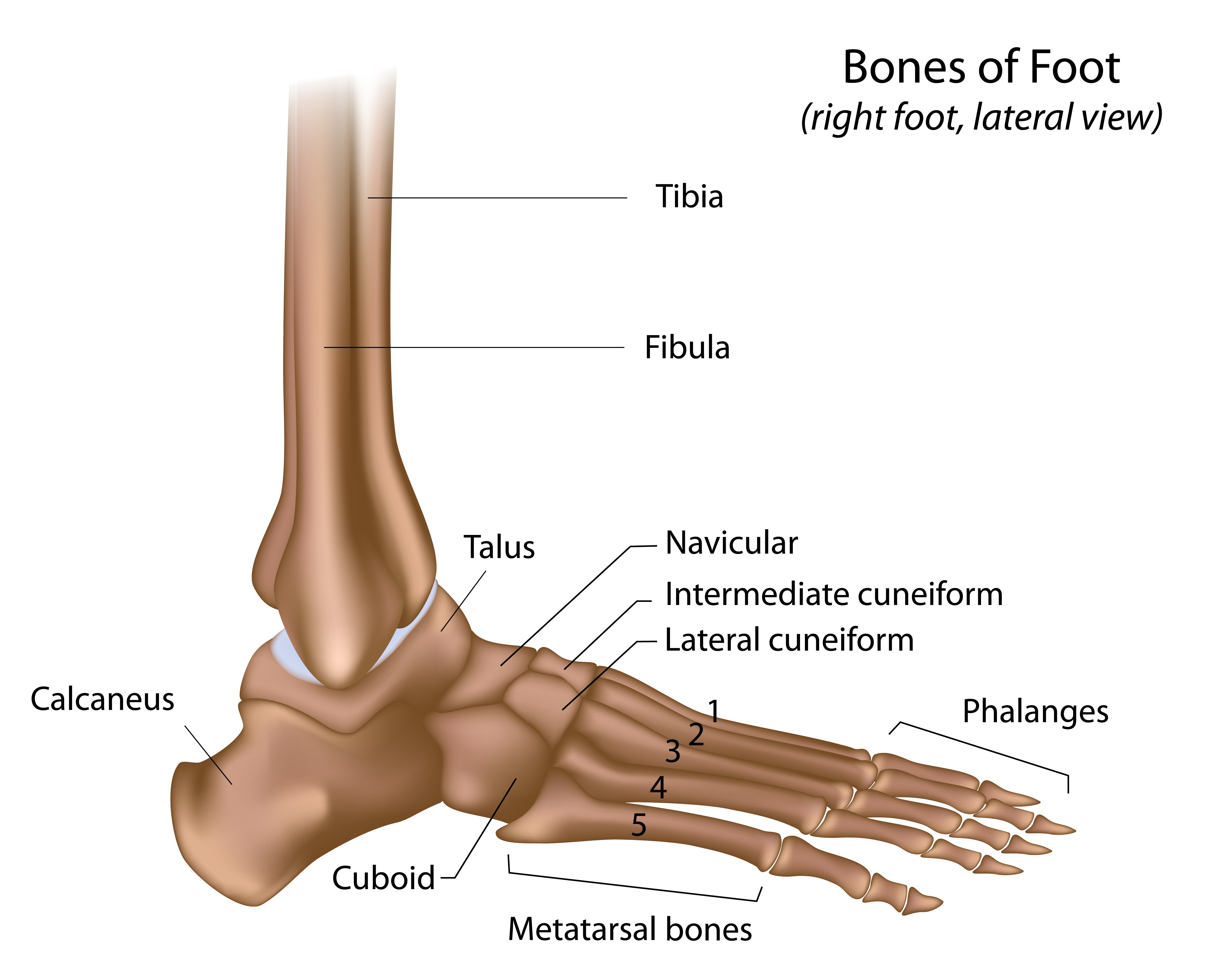
Pin on Body (of) Work
It is made up of over 100 moving parts - bones, muscles, tendons, and ligaments designed to allow the foot to balance the body's weight on just two legs and support such diverse actions as running, jumping, climbing, and walking. Because they are so complicated, human feet can be especially prone to injury.

Foot and ankle anatomy, conditions and treatments
Foot Diagram with Labels The foot is situated at the distal part of the lower limb. It is one structure that has undergone several evolutionary changes. The foot of humans has changed from grasping to a supporting structure. It supports the whole body weight while standing and also plays a vital role in locomotion.

Structure of the human foot bone Royalty Free Vector Image
Foot Bones - Names, Anatomy, Structure, & Labeled Diagrams Foot Bones Humans have 26 bones in each foot that are classified into three groups - tarsals, metatarsals, and phalanges. These bones give structure to the foot and allow for all foot movements like flexing the toes and ankle, walking, and running.

Anatomy of the Foot and Ankle OrthoPaedia
Anatomy of the foot Added to Saved items It may surprise you to know that the foot is one of the most complicated structures of the body. It contains a lot of moving parts - 26 bones, 33 joints and over 100 ligaments. Such complexity is necessary because the foot is required to do many different activities such as walking, running and climbing.

Diagrams of Foot 101 Diagrams
The foot serves as the terminal part of the limb responsible for bearing weight and enabling locomotion. Its skeletal structure comprises three main components: the tarsus, metatarsus, and phalanges.Tarsus:The tarsus consist of seven bones: the talus (forming the ankle joint superiorly), calcaneum (heel bone), navicular (medial bone), cuboid (lateral bone), and three cuneiform bones (medial.

Foot and Ankle Musculoskeletal Key
When to see a doctor Summary The foot is an intricate part of the body, consisting of 26 bones, 33 joints, 107 ligaments, and 19 muscles. Scientists group the bones of the foot into the.

Foot & Ankle Bones
The 20-plus muscles in the foot help enable movement, while also giving the foot its shape. Like the fingers, the toes have flexor and extensor muscles that power their movement and play a large.

Chart of FOOT Dorsal view with parts name Vector image Stock Vector Image & Art Alamy
The foot ( pl.: feet) is an anatomical structure found in many vertebrates. It is the terminal portion of a limb which bears weight and allows locomotion. In many animals with feet, the foot is a separate [clarification needed] organ at the terminal part of the leg made up of one or more segments or bones, generally including claws and/or nails.

bones of the foot Bones of the Leg and the Foot skeleton of the hindlimb Documentation for
Figure 1: Bones of the Foot and Ankle Regions of the Foot The foot is traditionally divided into three regions: the hindfoot, the midfoot, and the forefoot (Figure 2). Additionally, the lower leg often refers to the area between the knee and the ankle and this area is critical to the functioning of the foot.
.jpg?response-content-disposition=attachment)
Foot Bone Diagram resource Imageshare
Ankle joint Explore study unit Joints and ligaments of the foot Explore study unit Bones of the foot There are 26 bones in the foot, divided into three groups: Seven tarsal bones Five metatarsal bones Fourteen phalanges Tarsals make up a strong weight bearing platform.

Foot Description, Drawings, Bones, & Facts Britannica
Tibia Fibula Talus Cuneiforms Cuboid Navicular Many of the muscles that affect larger foot movements are located in the lower leg. However, the foot itself is a web of muscles that can perform.

anatomy of the foot Ballet News Straight from the stage bringing you ballet insights
The Anatomy of Feet | Foot Diagrams, Physiology, and Pictures - Bilt Labs The Anatomy of Feet | Foot Diagrams, Physiology, and Pictures Made From The Molds Of Your Feet Active Designed for an active lifestyle. View Active Insoles Everyday Designed for normal day-to-day use. View Everyday Insoles Take Free Orthotics Quiz

Foot pain looking up the chain
The muscles acting on the foot can be divided into two distinct groups; extrinsic and intrinsic muscles. Extrinsic muscles arise from the anterior, posterior and lateral compartments of the leg. They are mainly responsible for actions such as eversion, inversion, plantarflexion and dorsiflexion of the foot. Intrinsic muscles are located within.

Medial Muscles And Bones Of The Foot Sole Labeled Human Anatomy Diagram Stock Photo Download
LABELED DIAGRAMS. Figure 1. Sections and Bones of the Foot A. Lateral (Left) B. Anterior (Right) Figure 2. Compartments of the Foot A. Cut Section through Mid-Foot. Figure 3. First Layer of the Foot A. Plantar View of Right Foot. Figure 4. Second Layer of the Foot A. Plantar View of Right Foot.

Understanding the Foot & Ankle Scientific Publishing
33 joints more than 100 muscles, tendons, and ligaments Bones of the foot The bones in the foot make up nearly 25% of the total bones in the body, and they help the foot withstand weight..

Ankle and Foot Pain Massage Therapy Connections
The phalanges create the toes. Each toe consists of three separate bones and two joints, except for the big toe, which has only two bones — distal and proximal phalanges — and one joint, like the.